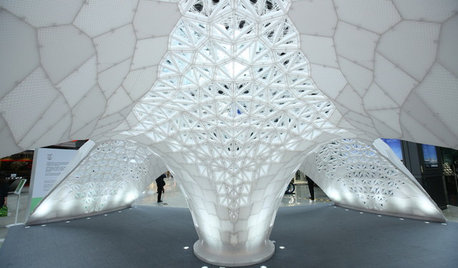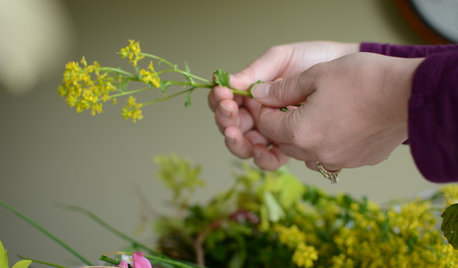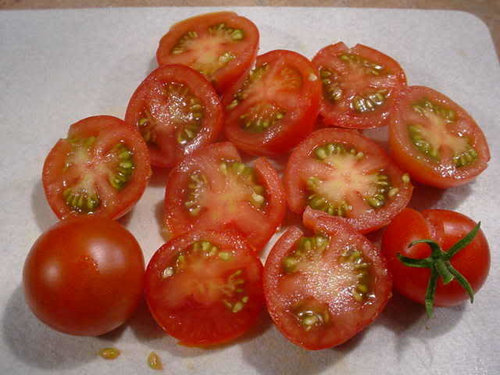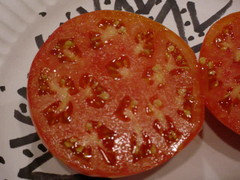Sungold's Wild 'Splitting' Gene???
HoosierCheroKee
16 years ago
Featured Answer
Sort by:Oldest
Comments (21)
bigdaddyj
16 years agolast modified: 9 years agobigdaddyj
16 years agolast modified: 9 years agoRelated Discussions
Stupid question re: Volunteers from last year's Sungold tomatoes
Comments (2)Most tomatoes self-pollinate, however there's still a chance of cross pollination from other varieties, especially by bees. Sungold has a very complex parentage, it's not a simple hybrid with 2 parents, so the chances of the volunteers being like Sungold will vary greatly. There's a chance if you get fruit that they can be orange, red, etc. If it were a simple hybrid bred from just 2 stable non-hybrid parents, you can usually expect something similar to either parent or something in-between the 2 parents. Many people attempted to "de-hybridize" Sungold and some have come up with an open pollinated stable variety, (actually a couple, Sungold Select and Sungold Select II) however they lack some of the outstanding flavor of the original F1 hybrid and many feel the original F1 is much better. There's a missing taste quality that amateur breeders & de-hybridizers cannot duplicate. Some have grown volunteers or saved seeds and have reportedly got similar tomatoes, though there's no real way of telling just how close to the original they are. And some have reported different colors and tastes. I think if you had that many plants, I'm sure they all should produce and maybe you can compare them to each other. The wild card in the mix is if they cross pollinated with the other varieties you grew last year, which would throw a monkey wrench into the predictions of what you'll get! So do grow them, compare them, and report your results. With so many plants between you and your friends, you may find one with that "missing ingredient." You'd get more replies about Sungold in the Tomato Forum at GardenWeb too, where others have grown both volunteers, later F generations, and intentional crosses. We'd be interested to hear/see your results! Hope this helps. Mark Here is a link that might be useful: Garden Web's Tomato Forum...See MoreMatts wild cherry question
Comments (34)First year growing MWC. It is an amazingly huge plant with impressive production. The taste is as sweet as it's reputation. My only knock on it is: 1. Very small fruit So I knew it was going to be small, but I guess I didn't know it would be that small. I'm also growing a variety called "Coyote" which is very productive like MWC, sweet like MWC, but yellow. I just wish I would get more bang per tomato in terms of size. I like the cherry size that are large enough to cut in half and add to salads. 2. Cemented to the vine So, staying on put on the vine is a good thing, but my MWC is almost cemented to it. When I pull them off, sometimes it's yummy meat inside stays with the vine. This makes it somewhat difficult to remove. Granted, this is early in the season and maybe this behavior will change. What I'd really love is a cherry tomato, the size of Magic Mountain but sweet like MWC. Does anyone have any suggestions? smithmal This post was edited by smithmal on Mon, Aug 4, 14 at 22:26...See MoreTomato plant smells: why is sungold different?
Comments (12)I'm in agreement that Sungold and also SunSugar plants have a definite, different smell. It is so objectionable to me that I will not snack on the friuts while picking these varieties. What I did notice yesterday while eating a few SunSugar fruits was that there is even a hint of that compound, that "objectional chemical",in the fruit taste that seems to improve the flavor profile somewhat. If you really want to smell an objectionable plant that reminds me of cat urine try growing the tomato grafting rootstock Maxifort. My belief is that these smells are a result of some wild plant parental strains used to breed these varieties. I would categorize the Sungold/SunSugar plant smell as medicinal. It reminds me of a sanitizer, similar to Rocal-D. Naturegirl, we probably just have the sensativity that others lack. I know that I can also readily detect Boar Taint(Androstanone) in pork fat that many coworkers fail to detect. So we can just agree that there are definite differences in our sensory perceptions. Ironically, the vast flavor differences of different tomato varieties that many talk about on this forum are not that apparent to me....See MoreWild Tomatoes
Comments (22)A much better canidate you might try seeking out are the varieties 'Nagcarlang' or "Phillipines #2" (or Fillipino #2). The only source I know of offhand is the place deemed nothing left to get out. The description of the Nagcarlang tomato type which follows has been made up in part from information given by Dr. Eugenio E. Cruz, Director, Bureau of Plant Industry. Manila, Republic of the Philippines and from Dr. Howard Peto, Peto Seed Company, Saticoy, California. The Nagcarlang tomato is the onlytype which will set fruit in high humidity areas throughout the Philippines. For this reason, during the winter of 1948--49, Dr. Peto called at Manila to see if the Nagcarlang tomato type could be used in a breeding programs so that a canning tomato for the Philippines would result. He also took tomato varieties, over to Mindanao and the Southern Philippines,of which Kolea and Anahu have proven adaptable. ... The Nagcarlang type has come into Ontario in two shipments. The first seed obtained has been written up in Scientific Agriculture 32:57-66, 1952. As far as is known the only surviving member in breeding programmes of the first shipment made to Ontario in 1948 is the type known as Philippine #2. Dr. Eugenio E. Cruz forwarded Nagcarlang to Guelph in the second shipment made in 1959, this seed having been gathered at Laguna in the Philippines. In the Philippines Nagcarlang is known to be a wild-type tomato. Its history is unknown. It is not a variety as no two plants are alike. It is simply a heterozygous form which has survived in the jungles of the Philippines and which has also been brought under cultivation and even sold commercially. Dr, Peto has verbally stated that in the Philippines the Nagcarlang type has survived-and become pollinated in areas with 100 inches of rainfall per season. He stated that it is hard to believe that such wild-type fruit could be sold commercially. However, he saw Nagcarlang fruits being sold when he visited the open market in Manila. He noted that the flowers hang down, shed the water, and do not experience as much blossom drop (in) rainy weather as is experienced by commercial types. While no two Nagcarlang plants are the same there are points in common. For example, practically all Nagcarlang fruits are small, very rough. and with a purplish "muddy" fruit colour. The fruits are firm and under Ontario conditions flat and sweet in flavour. They mostly ripen late in the season. The plants are very robust, and dense with healthy foliage. While Dr. Peto attributes fruit set under humid conditions to the flowers, the fact that the pollen remains active may have a chemical basis as the plants and fruits of the Nagcarlang type have a distinct purplish colour. In the Philipyines the Nagcarlang tomato is resistant to disease and to periodic drought. In Ontario it is tolerant to late blight. Under Ontario conditions it will set fruit at temperatures as low as 45 deg. F, which is 10 degrees below the point at which tomatoes normally set fruit. In other words, it is cold tolerant, It is interesting to note that in the tropics Nagcarlang is resistant to sterility caused by damp conditions and in Ontario, far removed from-the tropics, it is resistant to sterility caused by cool conditions. In the tropics the point of interest in to see if, through a breeding programs, the bridge can be gapped between the wild Nagcarlang type and the commercial varieties found on the North American continent. This would allow the commercial canning of tomatoes to be carried out in certain tropical areas such as the Philippines, where high humidity makes this difficult at the present time. From Graham, T. O, TGRC 1961, vol pg 36 the purplish/muddy appearance described would be similar to a black or cherokee purple like appearance. Phillipine #2 was the variety that the green flesh trait was studied and named. (green flesh is what makes green fruited varieties - when combined with the gene for yellow flesh - and blacks/purples - when combined with various red flesh genes) Most currants are fine in taste. Some do have a few off tones. Others, even when introgressed with regular tomatoes, may have initial bursts of flavor but also have nasty undertones or residual flavors. Kinda like Coyote and Green Doctors do, initally sweet perception followed by a nasty (astrigent in those instance) afterbite. Currants are also widely varied. Not all are resistant to disease....See MoreHoosierCheroKee
16 years agolast modified: 9 years agobigdaddyj
16 years agolast modified: 9 years agoMrClint
16 years agolast modified: 9 years agoHoosierCheroKee
16 years agolast modified: 9 years agovegomatic
16 years agolast modified: 9 years agoHoosierCheroKee
16 years agolast modified: 9 years agocarolyn137
16 years agolast modified: 9 years agoandreajoy
16 years agolast modified: 9 years agoHoosierCheroKee
16 years agolast modified: 9 years agobrazosvalleygardener
16 years agolast modified: 9 years agohortist
16 years agolast modified: 9 years agoHoosierCheroKee
16 years agolast modified: 9 years agobigdaddyj
16 years agolast modified: 9 years agobrazosvalleygardener
16 years agolast modified: 9 years agotomstrees
16 years agolast modified: 9 years agobigdaddyj
16 years agolast modified: 9 years agoHoosierCheroKee
16 years agolast modified: 9 years agobrazosvalleygardener
16 years agolast modified: 9 years ago
Related Stories

EDIBLE GARDENSSummer Crops: How to Grow Tomatoes
Plant tomato seedlings in spring for one of the best tastes of summer, fresh from your backyard
Full Story
ARCHITECTUREWhat the Future Holds for 3D Printing in Architecture and Design
Designers worldwide are creating 3D-printed buildings, furnishings and materials. Will we be seeing this trend in our homes?
Full Story
GARDENING GUIDESThe Quotable Garden: Writings That Will Grab Your Heart
Maybe you’ll see yourself in these reflections. Or maybe you’ll find a whole new way of looking at gardening
Full Story
Sponsored








brazosvalleygardener